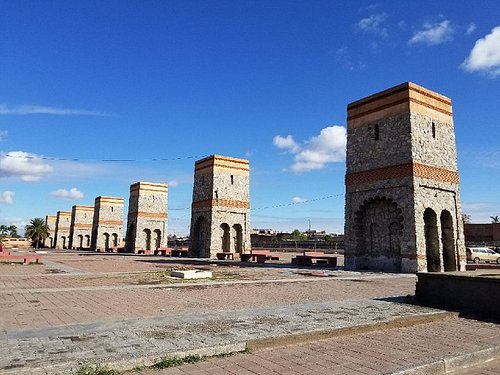Marrakech, a city filled with culture, history, and unmatched beauty, is an incredible destination of must-see landmarks. The place offers a captivating blend of traditional and modern attractions, from the bustling souks to the serene gardens. Visitors can immerse themselves in the vibrant colors, enticing aromas, and the rich tapestry of sounds that define this historic city.
Each landmark tells a story, painting a picture of Marrakech’s glorious past and its dynamic present. For those planning to explore the best of Marrakech, considering luxury concierge services for Marrakech can enhance the experience, offering personalized guidance to the city’s most iconic sights and hidden gems. These services ensure that every moment in Marrakech is as enchanting and memorable as the city.
Top 5 Tourist Destinations in Marrakech
Jardin Majorelle
Jardin Majorelle, a stunning garden oasis in the heart of Marrakech, is a visual masterpiece of vibrant colors and exotic plant life. This garden is a serene sanctuary originally designed by the French painter Jacques Majorelle and later restored by fashion designer Yves Saint Laurent. Its iconic cobalt blue highlights provide a tranquil haven from the bustle of the city, set against a backdrop of rich vegetation and unique floral species.
The Islamic Art Museum of Marrakech, which showcases jewelry, ceramics, and textiles from North Africa, is also in the garden. Visitors to Jardin Majorelle can wander along its shady paths, relax by tranquil streams, and immerse themselves in an artistic and botanical paradise.
Koutoubia Mosque
The Koutoubia Mosque, an architectural marvel, stands as a symbol of Marrakech’s rich Islamic heritage. It’s known for its striking minaret, which dominates the city skyline and is visible from miles around. As the largest mosque in Marrakech, Koutoubia holds significant historical and cultural importance.
Built in the 12th century, its design and decoration are a stunning example of Almohad architecture, featuring intricate tile work and arched windows. While non-Muslim visitors cannot enter the mosque, they can admire its impressive exterior, stroll in the surrounding gardens, and experience its spiritual atmosphere, especially during the call to prayer, which echoes throughout the city.
Bahia Palace
Moroccan architecture’s masterpiece Bahia Palace bears witness to the kingdom’s prosperous past. Constructed during the late 1800s, the aim was to encapsulate the spirit of Moroccan and Islamic design. The palace’s name, meaning ‘brilliance,’ is fitting for its elaborate design, featuring exquisite zellij tilework, painted wood ceilings, and lush courtyards.
Visitors can explore its beautifully decorated rooms and tranquil gardens, offering a glimpse into royal life. The palace’s serene atmosphere and intricate craftsmanship make it a must-visit destination for those looking to immerse themselves in Morocco’s cultural and architectural splendor.
Saadian Tombs
The Saadian Tombs, a historic royal necropolis in Marrakech, offer a unique glimpse into Morocco’s glorious past. Hidden for centuries and only rediscovered in 1917, these tombs date back to the Saadian dynasty in the late 16th century. The site showcases the exquisite Islamic architecture of the era, with its marble, intricate carvings, and detailed tilework.
The main mausoleum contains the graves of Sultan Ahmad al-Mansur and his family, with a lush garden surrounding the tombs, adding a tranquil beauty to the site. Visitors are often captivated by the peaceful ambiance and the ornate artistry, making the Saadian Tombs a profound testament to the city’s rich history and architectural prowess.
El Badi Palace
El Badi Palace, once a symbol of the Saadian dynasty’s wealth and power, stands today as an evocative ruin, offering a window into Marrakech’s imperial history. Built-in the late 16th century by Sultan Ahmad al-Mansur, the palace was known for its grandeur, with gold, turquoise, and crystal embellishments. Though now in ruins after centuries of pillage, its remnants hint at its former splendor.
Visitors can explore the extensive grounds, including restored pavilions and underground dungeons. The palace also hosts the annual Marrakech Folklore Festival, bringing the ruins to life. With its dramatic history and remaining beauty, El Badi Palace continues to be a significant attraction, resonating with the tales of a bygone era.
What is the Best Time to Visit Marrakech?
The best time to visit Marrakech is during the spring months of March to May and the fall months of September to November. Marrakech experiences mild weather during these times, making exploring the city’s bustling streets and sights comfortable.
Spring and fall months provide the best weather for outdoor activities, sightseeing, and cultural events since they escape the extreme heat of summer and the colder, less predictable winter weather. There are also fewer visitors during these times, making it possible to enjoy Marrakech’s distinct charm in a more laid-back and genuine way.
Recommendations for guided tours to enhance the visiting experience.
- Go for guided tours focusing on Marrakech’s rich history and culture, covering landmarks like Bahia Palace, Koutoubia Mosque, and the Saadian Tombs.
- Consider a guided tour of the Jardin Majorelle to fully appreciate its botanical beauty and artistic significance, including insights into Yves Saint Laurent’s influence.
- Explore Medina’s bustling souks and hidden alleys with a knowledgeable local guide for an authentic experience of Marrakech’s vibrant markets.
- Take a food tour to discover traditional Moroccan cuisine visiting local eateries and markets to taste dishes like tagine, couscous, and mint tea.
- Join a photography tour led by a professional photographer who can guide you to picturesque spots and teach you how to capture the essence of Marrakech.
- Consider a sunset tour with panoramic views of Marrakech from a rooftop terrace or a hot air balloon ride for a unique experience.

